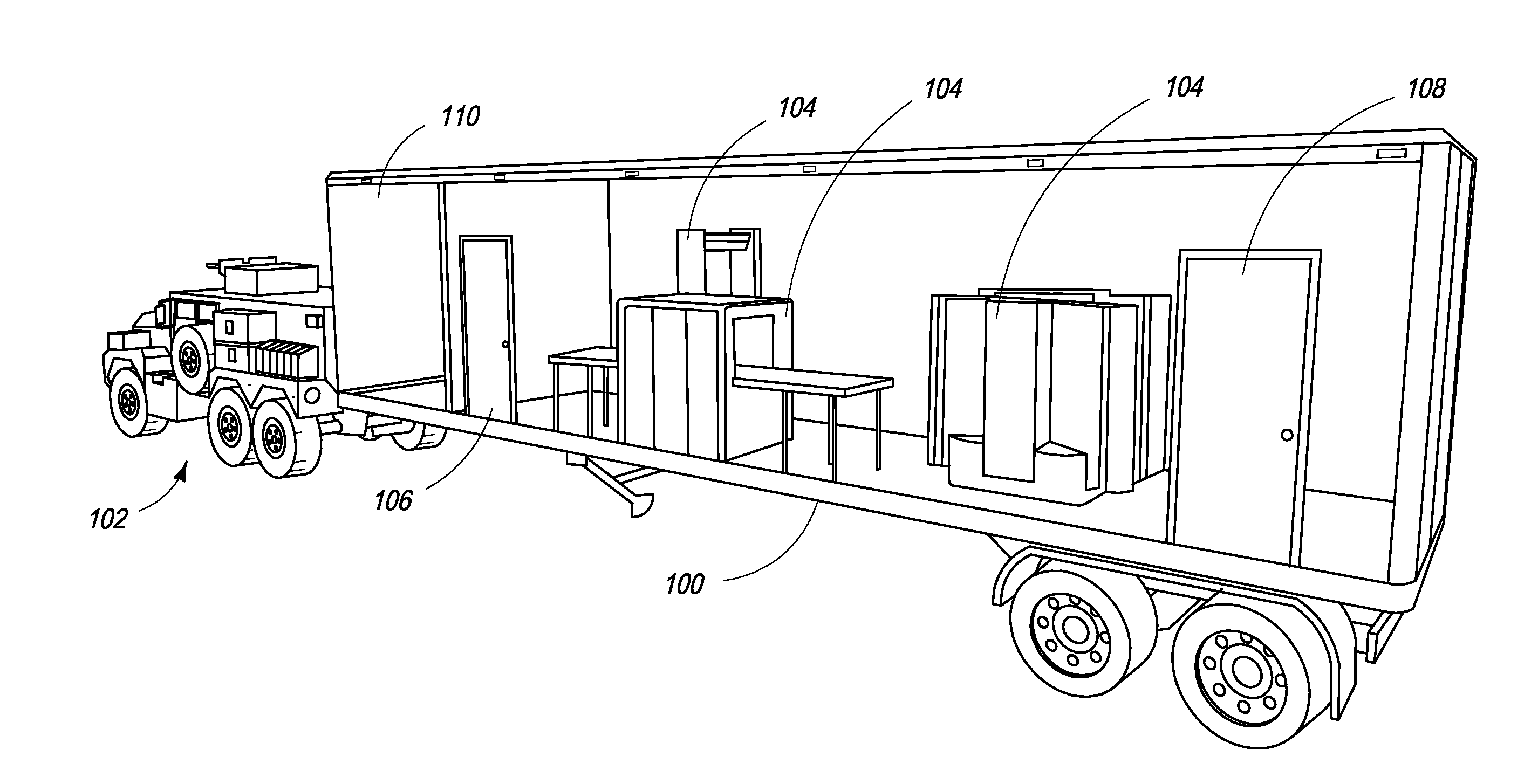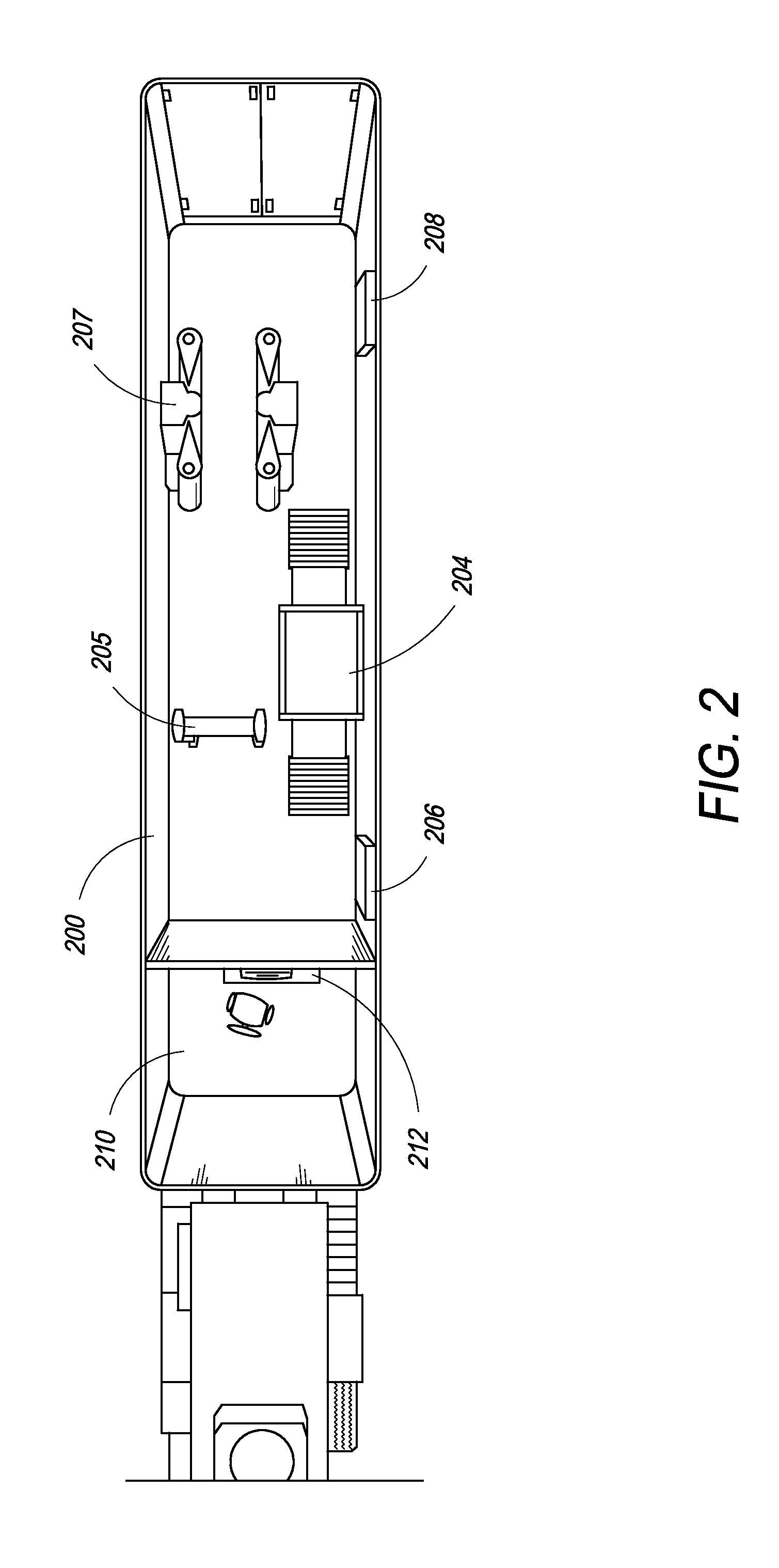Integrated portable checkpoint system
a portable checkpoint and checkpoint technology, applied in the direction of material analysis, material analysis using wave/particle radiation, instruments, etc., can solve the problems of affecting the overall society, unable to accommodate additional inspection facilities and difficult to find suitable space along the normal process rou
- Summary
- Abstract
- Description
- Claims
- Application Information
AI Technical Summary
Benefits of technology
Problems solved by technology
Method used
Image
Examples
first embodiment
[0059]FIG. 1 is an illustration of the integrated portable checkpoint system of the present invention comprising a single container and a tractor used to mobilize the integrated portable checkpoint container. In one embodiment, the integrated portable checkpoint container 100 is towed to a destination site by MRAP vehicle 102. In one embodiment, checkpoint container 100 comprises at least one internal checkpoint module 104. In order to allow for ingress and egress into and out of the internal checkpoint, in one embodiment the container includes an entrance door 106 on one end of one side of the container and an exit door 108 on the opposite end of the same side of the container to facilitate the flow of traffic.
[0060]In one embodiment, the at least one internal checkpoint module 104 is a baggage scanner similar to ones used at airports to scan carry-on luggage. A conveyor system passes baggage through a housing in which the baggage is subjected to x-rays in order to create an image ...
second embodiment
[0097]In a second embodiment, the boom of the present invention operates in a turntable fashion and comprises a horizontal boom section and a vertical boom section.
[0098]FIG. 7a is a rear view block diagram of one embodiment of a turntable design of the boom 700a of the present invention when fully deployed. In one embodiment, the boom comprises two sections: a horizontal boom section 705a, and a vertical boom section 710a. In this embodiment, an X-ray source 715a is attached to the side of the container 701a. The X-ray source 715a is positioned somewhere between the rear axle and the front of the container 701a. The boom 700a and X-ray source 715a are fixed to a horizontal rail or gantry system 720a that allows for horizontal sliding of both components along the length of the container 701a, between the rear axle and the front of the container 701a. Movement along the rail or gantry system 720a is synced and controlled by a computer so that the two components remain calibrated duri...
third embodiment
[0102]In a third embodiment, the boom of the present invention operates in a turntable fashion and comprises a horizontal boom section and a vertical boom section, and is vertically extendable by use of a hydraulic lift.
[0103]In the turntable with lift embodiment, a hydraulic cylinder or other similar lifting mechanism is included at the pivot point to enable scanning of vehicles with a height greater than that of the inspection container. FIG. 8 is a rear view block diagram of one embodiment of a turntable with vertical lift design of the boom 800 of the present invention in a vertically extended deployed configuration. The boom comprises three sections: a vertical hydraulic cylinder 835, a horizontal boom section 805, and a vertical boom section 810. In this embodiment, an X-ray source 815 is attached to the side of the container 801. The X-ray source 815 is positioned somewhere between the rear axle and the front of the container 801. In one embodiment, the X-ray source is vertic...
PUM
| Property | Measurement | Unit |
|---|---|---|
| temperatures | aaaaa | aaaaa |
| height | aaaaa | aaaaa |
| size | aaaaa | aaaaa |
Abstract
Description
Claims
Application Information
 Login to View More
Login to View More - R&D
- Intellectual Property
- Life Sciences
- Materials
- Tech Scout
- Unparalleled Data Quality
- Higher Quality Content
- 60% Fewer Hallucinations
Browse by: Latest US Patents, China's latest patents, Technical Efficacy Thesaurus, Application Domain, Technology Topic, Popular Technical Reports.
© 2025 PatSnap. All rights reserved.Legal|Privacy policy|Modern Slavery Act Transparency Statement|Sitemap|About US| Contact US: help@patsnap.com



